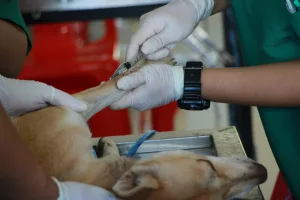Dogs are playful and intriguing creatures, often exhibiting behaviors that can leave us puzzled. One of the most common and amusing behaviors that many dog owners witness is their dog chasing its own tail. While tail chasing can seem like a harmless and comical act, it can actually indicate various underlying reasons and emotions behind this behavior. Dogs have a natural inclination to chase moving objects, including their own tails. This behavior can be traced back to their predatory instincts and genetic predispositions. In the wild, hunting animals is a key survival skill, and the act of chasing moving objects helps dogs hone their predatory skills and instincts. However, there’s much more to this behavior than meets the eye.
Understanding the Genetic and Instinctual Behavior
Dogs are descendants of wolves, and many behaviors they exhibit are remnants of those ancestral traits. Tail chasing is one such behavior. In the wild, wolves and other canines engage in play to practice hunting skills and to build social bonds within the pack. For domestic dogs, chasing their tails can be a vestige of these play behaviors.
Case Study: The Herding Breed
Consider herding breeds like Border Collies and Australian Shepherds. These dogs have been bred to chase and control the movement of livestock. Their inherent drive to chase can sometimes manifest in tail chasing, especially if they’re not given an outlet for their energy and instincts.
Tip: If you own a herding breed, provide plenty of physical exercise and mental stimulation. Activities like herding balls or participating in agility training can channel their instincts more productively.
Other Breeds and Their Instincts
It’s not just herding breeds; many other breeds have specific instincts that could contribute to tail chasing. Terriers, for instance, are known for their tenacity and drive to chase small animals, and this can translate to tail chasing when they’re under-stimulated. Hounds, with their high prey drive, might also engage in this behavior when they don’t have enough outlets for their energy.
Example: Jack, a young Jack Russell Terrier, lived in an apartment without a yard. His owner noticed that Jack often chased his tail. By introducing a routine of daily trips to the dog park and interactive fetch games, Jack’s tail chasing reduced significantly.
Physical Discomfort or Medical Issues
While playful tail chasing is often harmless, it can also signal that something is amiss physically. Dogs may chase their tails due to discomfort or irritation in the area.
Common Physical Causes
- Skin Allergies: Allergies can cause itching and discomfort around the tail area. This can lead to tail chasing as the dog tries to alleviate the itch.
- Parasites: Fleas and ticks are common culprits that can cause a dog to chase its tail. Regular flea and tick prevention is crucial.
- Anal Gland Issues: Impacted or infected anal glands can cause significant discomfort. Dogs often lick or chase their tails to try to relieve this irritation.
- Neurological Problems: Though rare, neurological issues can cause compulsive tail chasing. If your dog is chasing its tail excessively, consult your vet.
Professional Insight
Dr. Emily Richards, a veterinarian with over 15 years of experience, notes, “It’s crucial to rule out medical issues first when you notice frequent tail chasing. A thorough examination can help determine if there’s an underlying health problem.”
Additional Health Considerations
Beyond the common physical causes, there are other health-related factors to consider:
- Injuries or Irritations: Sometimes, a minor injury near the tail or hindquarters can cause discomfort, prompting a dog to chase its tail.
- Dietary Deficiencies: Occasionally, nutritional imbalances or deficiencies can lead to skin and coat issues, causing itchiness and tail chasing.
Tip: Ensure your dog’s diet is complete and balanced, and consult your vet if you suspect a dietary issue.
Behavioral and Psychological Reasons
Dogs are complex creatures with emotional needs similar to our own. Behavioral issues can lead to tail chasing, often as a way to cope with boredom, anxiety, or stress.
Boredom
A dog with pent-up energy or insufficient mental stimulation might resort to tail chasing. This behavior can be comparable to a human fidgeting out of boredom or restlessness.
Practical Tip: Engage your dog with puzzle toys, regular walks, and varied play sessions. A tired dog is a happy dog, and a happy dog is less likely to chase its tail out of boredom.
Anxiety and Stress
Tail chasing can be a coping mechanism for dogs experiencing anxiety or stress. This is similar to how humans might bite their nails when nervous.
- Separation Anxiety: Dogs left alone for long periods might chase their tails as a self-soothing behavior.
- Environmental Stressors: Loud noises, changes in routine, or new environments can trigger anxiety in dogs.
Example
Max, a four-year-old Labrador, started chasing his tail excessively after his family moved to a new home. The unfamiliar environment and routine disrupted Max’s sense of security. With gradual acclimatization and the use of calming aids like pheromone diffusers, Max’s tail chasing reduced significantly.
The Role of Routine
Dogs thrive on routine, and disruptions can lead to stress-related behaviors, including tail chasing. Maintaining a consistent daily schedule for feeding, walks, and playtime can help reduce anxiety.
Advice: If you anticipate a change in routine, try to introduce it gradually. For instance, if you’re altering feeding times, adjust by a few minutes each day until the new time is established.
Social Interaction and Attention-Seeking
Dogs are social animals that thrive on interaction with their human companions. Sometimes, tail chasing is simply an attention-seeking behavior.
Learned Behavior
If your dog receives attention from you every time it chases its tail—whether it’s laughter, clapping, or verbal encouragement—it might continue the behavior to engage you.
Advice: Instead of reinforcing the behavior, redirect your dog’s attention to a more appropriate activity and reward them for that. This can be achieved through positive reinforcement training.
Building a Strong Bond
Strengthening the bond with your dog through training and shared activities can reduce attention-seeking behaviors.
Tip: Regular obedience training sessions and shared activities like hiking or playing fetch can fulfill your dog’s need for attention and interaction in a positive way.
Training and Management
When tail chasing becomes excessive or concerning, it’s crucial to address it with effective training and management strategies.
Steps to Manage Tail Chasing
- Identify Triggers: Observe your dog to determine what might be triggering the tail chasing. Is it boredom, stress, or something else?
- Increase Exercise: Ensure your dog gets plenty of physical activity. Regular walks, runs, or playtime can help reduce unwanted behaviors.
- Mental Stimulation: Introduce puzzle toys, training sessions, and interactive games to keep your dog’s mind engaged.
- Positive Reinforcement: Reward your dog for engaging in appropriate behaviors instead of tail chasing.
- Consult a Professional: If the behavior persists, consider consulting a professional dog trainer or a behaviorist.
Tailoring Management to Your Dog
Every dog is unique, and effective management involves tailoring strategies to your dog’s specific needs and personality.
Example: For Bella, a high-energy Boxer, her owner found that two daily walks combined with an evening play session in the backyard significantly reduced her tail chasing.
Environmental Enrichment
Creating an enriched environment can help prevent boredom and reduce the likelihood of tail chasing.
Tips for Environmental Enrichment
- Interactive Toys: Provide toys that challenge your dog, such as treat-dispensing toys or puzzle feeders.
- Varied Play Areas: If possible, change play locations within your home or yard to keep your dog engaged.
- Socialization Opportunities: Arrange playdates with other dogs or visits to a dog park to provide social interaction.
Insight: Just like humans, dogs can become bored with the same routine. Regularly introducing new toys or activities can keep them mentally stimulated.
The Importance of Regular Veterinary Check-Ups
Regular veterinary check-ups are essential for maintaining your dog’s overall health and well-being, potentially catching issues that could lead to behaviors like tail chasing.
What to Expect During Check-Ups
During a check-up, your vet will:
- Perform a physical examination, checking for any signs of discomfort or abnormalities.
- Discuss your dog’s diet, exercise routine, and behavior.
- Provide guidance on preventive care, such as vaccinations and parasite control.
Professional Tip: Don’t wait for annual check-ups if you notice changes in your dog’s behavior. Early intervention can prevent minor issues from becoming major problems.
Understanding Your Dog’s Communication
Dogs communicate through body language and behavior, and tail chasing might be a way for your dog to express something.
Observing Body Language
Pay attention to your dog’s overall body language when tail chasing occurs:
- Relaxed Posture: If your dog is relaxed and playful, the tail chasing might be harmless fun.
- Tense or Anxious Behavior: If your dog appears tense, with ears back or tail tucked, they might be chasing their tail due to anxiety or discomfort.
Advice: Understanding your dog’s body language can provide insight into their emotional state and help you address underlying issues effectively.
Dogs, with their unique personalities and behaviors, often communicate more than we realize through actions like tail chasing. By paying close attention and being proactive in addressing their needs, we can ensure our companions lead happy, healthy lives. Tail chasing, though sometimes perplexing, can be better understood and managed through a combination of observation, enrichment, and care.



